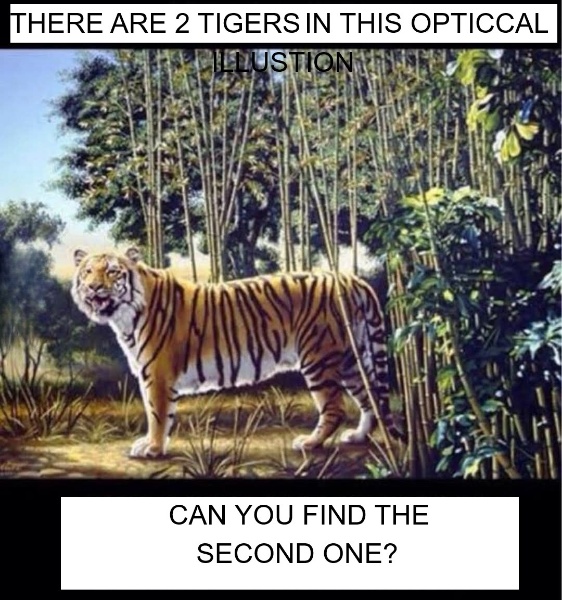The internet loves a good challenge, and the latest viral optical illusion is leaving people scratching their heads. At first glance, it appears to be a simple image of a tiger. However, the real challenge lies in finding the second hidden big cat within the picture.
While many people search the dense background for another tiger, the answer is far more subtle than expected. Think you can spot it? Let’s break down this mind-bending illusion and explore why optical illusions continue to fascinate us.

The Hidden Tiger Optical Illusion: A Test of Perception
The optical illusion making waves across social media features what looks like a single tiger standing in a jungle scene. Many viewers immediately assume there’s a second tiger camouflaged somewhere in the foliage. They search behind trees, among the grass, or hidden in the shadows.
But the trick isn’t in the background—it’s in plain sight. The second “tiger” isn’t an actual animal but rather a clever manipulation of the first tiger’s stripes. The words “The Hidden Tiger” are subtly embedded within the tiger’s fur pattern, forming the illusion of a second tiger.
Video: SPOT THE HIDDEN TIGER PUZZLE
Why Do Optical Illusions Trick Our Brains?
Optical illusions work by manipulating how our brains process visual information. Our minds rely on patterns, depth perception, and past experiences to interpret images quickly. However, illusions like this one challenge those instincts by presenting an unexpected twist.
In this case, our brains expect to find a physical second tiger rather than a hidden message. This expectation makes it difficult to recognize the words right away. Our natural tendency is to search the environment rather than question whether something is disguised within the tiger itself.
The Science Behind Optical Illusions
So, why do our brains fall for these visual tricks? The answer lies in cognitive processing and perception.
- Gestalt Theory – This psychological principle explains how we perceive whole images rather than individual parts. Our brain tries to group similar elements together, which is why we focus on the jungle scene rather than the details within the tiger’s fur.
- Figure-Ground Perception – This refers to how we distinguish objects from their backgrounds. In this illusion, our eyes separate the tiger from its surroundings, but we don’t immediately register the hidden words within its stripes.
- Selective Attention – Our brains prioritize certain details while ignoring others. Since we are conditioned to think of tigers as animals, we search for another living tiger rather than words disguised in the pattern.
Video: There Are 2 Tigers In This Optical Illusion. Can You Find The Second One
How Optical Illusions Have Become an Internet Phenomenon
The rise of social media has made optical illusions more popular than ever. From color-changing dresses to moving patterns, these puzzles challenge users and spark debates in the comment sections.
There are even dedicated websites that showcase these mind-bending images, including the Best Illusion of the Year Contest. This annual event celebrates creativity in visual perception, bringing together scientists, artists, ophthalmologists, and neurologists to study how illusions manipulate the brain.
According to the contest’s website, the event is an initiative of the Neural Correlate Society (NCS), a non-profit organization that promotes scientific research into perception and cognition. Experts in various fields collaborate to uncover how the human brain processes visual information and why we see illusions in specific ways.
The Hidden Tiger: A Lesson in Perspective
What makes this optical illusion so effective is its simplicity and deception. Most people struggle to spot the second “tiger” because they are looking for something familiar. However, once you see the words in the stripes, you can’t unsee them.
This illusion serves as a great example of how our perceptions can be misleading. It’s a reminder that sometimes, the answers we seek are right in front of us—we just need to adjust how we look at things.
If you spot the second tiger in this optical illusion you’re in the top 1%
— Let's Fookin' Gooooo!!! (@bitcoininvestr) June 7, 2022
Don't give it away. Like if you spot it. pic.twitter.com/V9G4rcmQYu
Why We Love a Good Optical Illusion
People are naturally drawn to visual puzzles for several reasons:
- They challenge our brains – Trying to decipher illusions helps keep our minds sharp and engaged.
- They create a sense of accomplishment – Spotting the hidden trick before others can feel like a major win.
- They spark curiosity and discussion – Whether it’s debating over “The Hidden Tiger” or the infamous “blue or gold dress” illusion, these puzzles encourage people to share opinions and theories.
- They highlight how fascinating the brain is – Optical illusions remind us that our perception of reality isn’t always as reliable as we think.
Final Thoughts: Can You See the Hidden Tiger Now?
At first, spotting the second tiger in this illusion seems impossible. But once you shift your perspective, the answer becomes clear—the hidden tiger is not an animal, but the words “The Hidden Tiger” cleverly placed in the stripes.
Optical illusions like this one prove that things aren’t always as they seem. Sometimes, a simple change in how we look at something can completely transform our understanding of it.
So, did you find the second tiger before reading the answer? Let us know what you saw first!